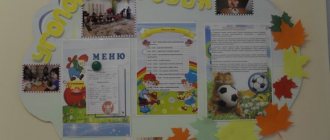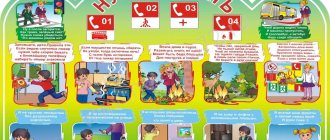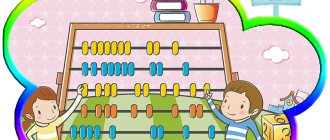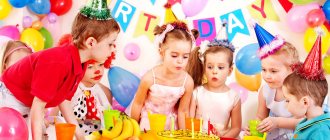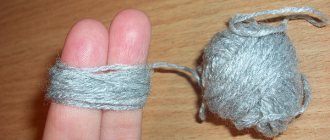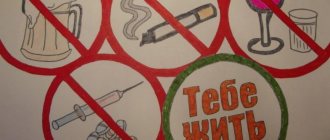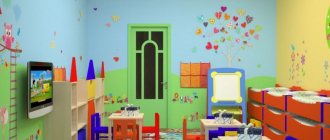Beautiful pictures on different themes for school stands will help creative students design the most impressive stand for their school. Children will be able to supplement their work with templates for various sections on the stand, as well as with their own drawings. It is noteworthy that self-made stands have many advantages: exclusive design, thoughtful information content and involvement in the creative process. We offer you the most complete selection of pictures for creating school stands.
School safety pictures: child safety stand
The main task of the school safety corner is to familiarize students with possible dangerous situations and teach them to act correctly in case of danger to their health and life. Thanks to the correct information provided in the safety corner, each student receives knowledge of how he should behave in threatening situations:
- on the street, especially on roads;
- in case of flood, snowfall, terrorist attack;
- in case of fire;
- when meeting strangers;
- when working with electrical appliances or hazardous chemicals.
Students enjoy learning important information when it is taught through activities with pictures of children. Visual pictures should be simple, colorful and understandable for children of a certain age.
where to call the police, ambulance, fire department
To design the stand, use color templates with zones for placing important safety sections:
ABC of safety on the road, in case of fire, personal safety
Materials in the form of visual posters for assimilation of algorithms for children’s actions in certain dangerous situations:
single emergency number
personal safety on the street
safety rules for children in pictures
ice safety rules
safety rules in the heat
electricity safety rules
safety rules during a thunderstorm
rules for using a fire extinguisher
water safety rules for children
rules of conduct fire in the forest
hurricane rules of conduct
Formation of the middle group.
Svetlana Yurieva
Formation of the middle group.
This summer we moved to a new group . After the previous one, where we lived for 2 years, this group seemed alien , not cozy, and after some thought, our parents decided to organize a cleanup day on their own, which, however, lasted 3 days. Without sparing their weekends, our parents came to our aid.
Assembling the kitchen set
Washed the group after painting
The team has arrived - just right!
Then it’s just a matter of making the group not only clean , bright and spacious, but also interesting for children. That's why I created development centers:
Fine, which was replenished with various means of depiction
Streets of our city according to traffic rules
Music and theater areas
Pochemuchek Corner - experimental zone
Center for Young Mathematicians
Children go to kindergarten with pleasure, everyone will find something to their liking.
Kindergarten decoration File “/upload/blogs/aa327c36105f8186cd0df59e99c44fa3. pg.jpg" not found. Subject-developmental environment of the group (middle preschool age). .
www.maam.ru
Providing first aid to the victim: pictures with actions for children
Placing school stands with the basics of first aid in pictures is more than justified from the point of view of the human subconscious. Numerous studies have shown that daily viewing of certain information, particularly in the form of images, is quite successful in remembering, even if it was not carefully read.
In elementary schools, it is preferable to use beautifully designed posters with large drawings or stands, the information content of which should be concise and dynamically replaced (for example, once every 3-6 months). For older children, large corners with a variety of information, both in pictures and in print, are suitable.
first aid stand: templates
first aid pictures
Schemes and images for filling the stands:
action pictures for kids
First aid steps in pictures:
thermal burn
food poisoning
abrasion
solar heatstroke
limb fracture
puncture or cut wound
nose bleed
eye damage
frostbite
fainting
Psychologist's corner: pictures for decoration
Within the walls of a school, one of the most important tasks that psychologists have to solve is psychological support and education of students, as well as their parents. The “Psychologist’s Corner” comes to the rescue, which is important to update every few months. To fill the information stand, you have to select useful and relevant information, pictures and tables. To get readers interested, it is better to choose colorful, interesting and well-designed material.
The priority topics for filling the psychologist’s stand are:
- Difficulties in learning.
- Atmosphere in the classroom.
- Relationship with parents.
- Self-development and self-discipline.
- Determining the path of life.
We offer you free pictures with suitable and aesthetically beautiful information to fill school psychologist stands.
psychological safety of a child: pictures
psychologist's advice to parents of children
Templates for ready-made attractive psychologist posters with useful information, as well as bright pictures with rules:
Templates for psychologist stands with headings:
School of occupational safety and health: pictures for registration
An established labor protection system in educational institutions allows for the organization of a safe educational process. It is aimed at protecting the health and life of all workers. In addition, it includes social, legal, and rehabilitation measures.
The labor protection stand within the school walls is an information block containing information about training, as well as provisions on organizational processes that ensure proper labor protection and safety.
You don’t need to fill your stand with only official documents and instructions. You can enter information about first aid measures in case of emergencies, rules of behavior for workers, actions in the event of work-related injuries, as well as instructions on labor protection and electrical safety, and rules for working with a computer.
Materials for the school stand on labor protection:
Occupational safety and health stand templates:
Occupational safety briefings in pictures:
covid 19 pictures
The current section of the labor protection stand was the information block about COVID-19:
Information stand for parents “Child safety comes first”
Safety
child comes first
Security is “... a state of protection of the vital interests of the individual, society and the state from internal and external threats” (Article 1 of the Law of the Russian Federation of March 5, 1992 No. 2446-I “On Security”).
In the modern world, no one is immune from disasters or natural disasters. We feel special concern for defenseless little citizens - preschool children. Today, life itself has proven the need to teach not only adults, but also children the basics of life safety. Indeed, in conditions of social, natural and environmental disadvantage, a child’s natural curiosity can become unsafe for him. Preparing a person for a safe existence in the environment should take place at all stages of a person’s life, and it must begin from preschool age. The task of teachers and parents is not only to protect and protect the child, but also to prepare him to face various difficult and sometimes dangerous life situations.
Work in this direction largely comes down to finding answers to the questions: “How can I help understand the variety of life situations? How to protect your child's health? How can we teach them to help each other?”
After the introduction of the Federal State Educational Standard. The modern world has changed its approach to the problem of security; it has also included such concepts as environmental disaster and terrorism.
The content of the educational area “Security” in preschool educational institutions is aimed at achieving the following goals:
Forming the foundations for the safety of one’s own life through solving educational problems:
— acquaintance with household sources of danger, with the necessary actions in case of danger, the formation of ideas about methods of safe behavior in everyday life;
- fostering a sense of mutual assistance and camaraderie.
Formation of prerequisites for environmental consciousness (safety of the surrounding world) through solving educational problems:
- formation of ideas about situations that are dangerous for humans and the natural world and methods of behavior in them;
— familiarization with the rules of behavior that is safe for humans and the natural world around them;
— transferring to children knowledge about road safety rules as a pedestrian and a passenger in a vehicle;
— formation of a cautious and prudent attitude towards situations that are potentially dangerous for humans and the surrounding natural world.
The safety formula for children reads:
“We must see, anticipate, take into account, avoid if possible,
if necessary, call for help"
Child and nature
Parents, going with their children to the countryside or nature, sometimes lose their vigilance. But in vain! For example, no one has yet canceled the disease of dirty hands. And there are more than enough other dangers around. Curious kids can get hurt by sharp pruners or shovels. So it doesn’t hurt to brush up on personal safety rules and convey them to your child.
Harmful instruments
There are tools hidden in grandpa's barn, and this is much more interesting than children's toys! Little Kulibin will want to try out how a lawn mower works, what a pruning shears are for, and how to work with an “adult” shovel. What should I do? Castles can be saved, but only if the child is under five or six years old. Older children cope with this obstacle using pins, twigs, and mother's hairpins. It’s better if the grandfather himself shows the child the curious contents of the barn, explains how to use it, lets him hold the tools and definitely (!) explains safety precautions.
Problems with dirty hands
Let your mother or mother-in-law talk as much as they want about organic tomatoes and cucumbers from their garden plot or greenhouse, but you should not encourage your child to eat something directly from a garden bed or bush. Dirty hands coupled with “acid rain” have already put an end to this topic. What should I do? Teach your child to wash fruits, berries and vegetables before trying them. You need to start at home, then the baby himself will explain to his grandmother why he takes the cucumber to the sink and not straight into his mouth. If possible, install a washbasin right in the garden so that your child does not have to run into the house every time he wants to eat his vitamin. And strictly prohibit grandmothers from setting a different example for their child.
The dog can be a biter
Let them say that the greatest danger to a person is the person himself, but a clash with our smaller brothers does not always bode well. Strange animals and unfamiliar plants pose a threat to the baby. After all, not a single household farm can do without representatives of flora and fauna. The bright colors of the Colorado potato beetle attract children no less than homemade toys - they just want to catch it, touch it, hide it in a matchbox and feed it grass.
Petting a chained dog is also a bad thing for a fool. What should I do? Teach your child to communicate with the world of wildlife at a distance. Explain that it is forbidden to touch plants or pick flowers, no matter how beautiful they are: tell them that flowers are hurt and offended when this is done to them. Come up with similar stories about animals, insects, birds to show your child: you need to treat nature on a first-name basis, then she will be kind. Do not scare your child with the words “poisonous” or “harmful” - this will only fuel interest in the forbidden. It’s better to tell us what’s good about these bugs and spiders, why they don’t need to be offended and destroyed.
Costs of forest walks
It’s better to forget the saying “every speck in the forest is a vitamin” as soon as possible. Kids like to collect cones and twigs, run after butterflies and catch insects, look into nests and watch squirrels. But children under 3-4 years old still explore the world with the help of their lips and tongue and put “all kinds of infection” into their mouths. And older children still do not distinguish harmful plants and insects from harmless ones. What should I do? For five-year-old children, urgently begin an educational program on the flora and fauna of their native forests, thereby preparing them for zoology and botany lessons. With younger children, be attentive and don’t forget to take a pack of wet wipes on walks to wipe your baby’s hands.
Hide and seek without loss
As you know, the game of hide and seek is very popular among children of five to seven years old, especially since there is a place to disguise themselves in the forest. Adults know the dangers of this fun - children can get lost. What should I do? Strictly outline the boundaries for the game: we hide from that edge to those bushes. At the same time, it is better for you, an adult, not to take part in the game as a leader, but to observe from the side where the children are hiding and make sure that they respect the boundaries of the playing field. It’s ideal to invite kids to play “hide-and-seek in disguise” rather than traditional hide-and-seek. Competition for the best mask outfit: allow yourself to be sprinkled with leaves, branches, and lie on the grass to become invisible against the background of the forest. It's better to sacrifice clean clothes than to worry about your baby's safety.
Child on the street
When ensuring the safety of children on the street, remember that:
- There is no need to wear expensive jewelry and other expensive accessories for your child when going outside.
- There is no need to hang your keys around your neck or in another visible place (put them in a secret pocket).
- A child should not talk to strangers, go anywhere with them, take anything from their hands, get into a car, etc. Be sure to talk to your child about not answering questions about where the adults are, who is at home, where things are at home, etc.
- The child should know that he must always look both ways (so as not to end up under the wheels of a car) when leaving the entrance, crossing the road, or while playing in the courtyard.
To keep children safe on the street, parents must teach them lessons about “who am I.” So the child should know the following personal information:
- His first name, last name, home address and telephone number, as well as the names of his parents.
- It is also necessary to learn with your child what dangers/injuries can be received by him or other children: do not touch sharp, heavy, hot things (so as not to get hurt, bumped, or burned).
Rules for safe behavior of children on the street
- You cannot talk to strangers, take any objects from their hands, or leave with them. If a stranger wants to use force, teach your child to scream and run away, call for help.
- You must not take dangerous objects from the ground or even approach them: syringes, knives, broken bottles, strange packages, etc.
- You cannot run away from your parents, hide from them, run into rooms, or transport without parents.
- Talk and learn the child’s model of behavior if he is lost (what he should do, what information about himself to give, how to call for help).
- Learn with your child the basic rules of behavior on the road (when to cross the street, a ban on playing near the road, etc.).
Remember that you need to gradually teach your child to be independent. Do not scare your child and do not tell about all the dangers at once. Present the information carefully, methodically (you can keep a notebook and note which points you have already talked about and what you will talk about next time). Don’t forget to work through the same topic several times and remind them of certain important points. Accompany the learning process with pictures.
In the process of learning the rules for safe behavior of a child on the street, involve relatives in demonstrating role-playing scenes. Show how to behave on the street by your example, broaden your child’s horizons. And also ask the child to show how he remembered what you told him.
Child at home
When was the last time you crawled around the apartment on your knees? The question seems strange, but it arose for a reason. Children explore their surroundings every day, climbing into the most unexpected places and grabbing objects that were not at all intended for them. Inspect the entire house before the child to eliminate things that are potentially dangerous to the baby. Many parents believe that special precautions need to be taken if there are babies in the house who are just starting to crawl and walk. However, older children also often suffer household injuries.
Safety precautions for children can be represented by a set of rules that relate to:
* behavior in dangerous and emergency situations;
* use of all kinds of household electrical appliances;
* child’s access to objects that may pose a potential danger to him (this includes scissors and knives, a computer and the Internet, a first aid kit with medications, etc.);
* communication with strangers who may call or come.
More than a third of accidents that occur in children under 14 years of age occur at home. And many of them could have been avoided if parents had taken the safety of their children more seriously. Children under 4 years of age are at greatest risk. The best way to prevent accidents with your child is not to leave him unattended. But even the most attentive parent is not able to monitor the child every second of the entire day. It only takes one moment for children to run to a hot oven, grab a knife, or put found pills in their mouths.
How can you ensure your child is safe at home?
First of all, we must remember what most often causes domestic injuries and accidents at home:
Water - in the bath, in the kitchen, in water supply and heating pipes.
Fire and hot objects, such as an oven.
Poisonous substances and medicines. Many housewives store household chemicals under the sink in the kitchen or bathroom. And often children crawl into these secluded corners more often than mothers. Many medications are also often kept “at hand,” that is, within the child’s reach.
Fall hazards include stairs, slippery floors, tall furniture and windows. Consider how you can avoid these dangers. Do not leave your child unattended in the bathtub or near the pool. Keep matches, lighters, piercing and cutting objects, toxic substances and medications out of the baby's reach. Do not leave your child alone in a room with an open window.
Remember that a mosquito net does not prevent a child from falling. Quite the contrary - it creates the illusion of a reliable barrier, and the child can lean on it.
A 3-year-old child is not able to understand the reason for the danger of a particular object. But it can already be explained to him that fire can be very painful. And that you can take medicine only if the doctor orders it. For clarity, you can tell a story about a girl/boy who ate pills without asking, became very ill, and had to be taken to the hospital. This will not guarantee your child's safety, but will slightly reduce the risk of an accident. Be a good role model - if you don't let your child sit on the edge of the bathtub or on the windowsill, don't do it yourself.
Young children are very inquisitive and restless. Bans alone cannot force them to play all day on the carpet in the center of the room. When prohibiting your child from playing in a certain place, be sure to offer him a safe alternative. If your baby has a “house” under the sink, invite him to make a shelter under the table in the room. Use your imagination to make the new place more attractive for your baby - hang a blanket instead of a wall or use empty boxes as furniture.
Try to look at the house through the eyes of a child to understand where danger may await him. It’s better to play it safe than to regret your own carelessness later.
Stands for elementary school pictures
Each classroom corner in an elementary school is a basic information platform for students and their parents. In this classroom area, it is customary to place stands with up-to-date information about the features of children’s adaptation to school, school events, classroom and extracurricular activities.
Since the first days of school are dedicated to new meetings and acquaintances, it is better to start by setting up a stand on the theme “Meet us!”, “Hello school!” etc. For work, you can use templates of posters and classroom corners.
An excellent material for a school stand would be picture reminders for parents of first-graders, which will help prepare their children for school.
Useful cards with rules of behavior, daily routine, information about students for the school stand:
Anti-terror pictures for the stand
Anti-terrorism stands are placed within the walls of schools and other educational institutions in order to ensure effective anti-terrorist security of both the facility itself and students and employees.
At the stands you can find all the necessary information, which is updated regularly, namely:
- Activities aimed at identifying and preventing possible terrorist threats.
- Suppression of any initiatives associated with terrorism.
- Algorithm of actions in the event of a terrorist threat.
Poster templates for anti-terror stand:
Materials for filling the stand:
Why do you need a safety corner?
Any mother will tell you that kids don’t know the feeling of danger, that’s why they get into trouble, gradually learning from their mistakes. The task of the school and parents is to warn the child against certain mistakes that could cost him his life, and also to teach him what to do in case of an emergency. The list of dangerous situations includes: road traffic, fire, being on ice in a reservoir, terrorist attack.
You will be interested in: Tajik Soviet Socialist Republic: capital, borders, population, history of creation and development
By constantly telling and repeating information from the safety corner, parents and teachers will help the child form the correct algorithm of actions in the event of an emergency.
Firefighter stand clip art
Fire safety stands should be located in the school in publicly accessible places where large numbers of students most often gather, for example, near the entrance to the dining room or assembly hall. This is necessary for regular information and promotion of fire safety measures to students. Thanks to a well-designed and understandable information block on the stand, all school visitors will be aware of the rules of behavior that prevent fire. And thanks to the instructions on the stand, in the event of an emergency, everyone will act in case of fire.
What should be placed on a stand in an educational institution:
- Factors causing fires.
- Emergency numbers.
- Rules of conduct in case of fire at school.
- Dangerous consequences of fires.
- Schematic plan and actions during evacuation.
Poster templates for fire stand:
Pictures for filling the fire stand:
Ice safety rules
I remember that as a child, the teacher, releasing the class for the winter holidays, spent class time on the rules of being on the ice, which the students then signed in a special notebook. And we signed that we had learned and adopted the following rules:
- do not walk on ice for no apparent reason;
- do not gather several people in one place;
- what actions to take if the ice cracks under you (sliding steps, feet shoulder-width apart);
- what to take with you on the ice (rope with a load, phone, etc.);
- what to do if you fall through the ice (rolling technique).
Traffic regulations pictures for the stand
Students learn traffic rules everywhere: at home, during walks with their parents, during life safety lessons at school. Corners with visual traffic rules help to consolidate the acquired skills so that you can be safely on the street, especially when crossing the road. At the stand, students see the possible dangers that await them on the streets, the rules for crossing the road, road signs and their meaning.
Pictures for decorating the traffic rules stand:
Design of thematic areas in kindergarten
Showing publications 1-10 of 4579. All sections | Corners and centers in groups
Educational environment. Interesting corners in our group
Dear colleagues, I invite you to a mini excursion to our group. Our tour begins with a reception for children and parents. I tried to make it interesting for children and parents; when you go into the locker room you can see a stand “For moms and dads about the lives of their children.” Available at this stand.
Busy board - development center
Good day, dear friends and guests of my page! Probably, many of you have heard about a development board for children, on which there are various fasteners, doors, buttons, etc. This development center is called a busy board. It was invented by Maria Montesori. Busyboard.
Sources
- Victor Mikhailovich Koryakin Arbitration process in schemes. Tutorial; Prospect - M., 2000. - 370 p.
- Smirnova 100 golden rules. Caring for indoor plants / Smirnova, Maria. - M.: Fiton+, 2008. - 160 p.
- Vox Juris collection. Voice of Law / Collection of articles. - M.: St. Petersburg State University, 2021. - 919 p.
- Alexander, Vasilievich Demin “Soft law” in an era of change: the experience of comparative research. Monograph / Alexander Vasilievich Demin. - M.: Prospekt, 2014. - 182 p.
- Law and Economics No. 08/2010; Justitsinform - M., 2010. - 839 p.

